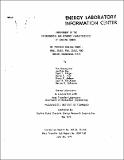| dc.description.abstract | This report describes research for the past year on methods to enhance
the environmental and economic performance of dry cooling towers.
The work has concentrated on dry cooling towers utilizing periodic water
to air heat exchangers. Periodic towers have sheet metal discs partially
submerged in hot, power plant condenser effluent. As the discs rotate, the
discs alternately absorb heat from the effluent and discharge heat to the
air. The means of heat transfer on the air side can be either evaporative
and/or convective, depending upon the amount of effluent carried into the air
side on the surface of the plates. An oil layer, floated on the water's
surface, has been shown to be effective in eliminating water carry-over to the
air side.
The advantages of the periodic tower lie in the low cost of the discs and
the ability to operate dry . A periodic tower should be significantly less
expensive than a conventional dry tower fabricated with finned tubes. Further,
since the periodic tower can also operate wet, by removing the oil film, the
high capacity losses incurred during warm months by conventional dry towers
can be eliminated.
In the past year, tests on a 20 inch model of the periodic tower indicated
that at operational speeds of the full sized disc, no noticeable churning
of the oil layer ocurred. Heat transfer rates measured with the 20 inch model
were 20 percent higher than predicted by an approximate analysis. Finally,
silicone oils' low vapor pressure make them superior to hydrocarbon oils on
the basis of evaporation rates, but their higher costs and possible ecological
impact necessitates a closer look at hydrocarbon oils.
Construction of the full scale test facility is complete. Shaped, rigid
five foot diameter discs have been designed, fabricated, and assembled into
an initial test module. Instrumentation for heat transfer tests is also complete; including instrumentation for measuring disc temperatures, and both air
and water flow rates and temperatures. A parametric study of the oil film thickness on the air side of the test module has been completed. Measured
thicknesses were 20 percent less than that previously predicted. This thinner
oil layer means an increase in the disc heat transfer.
A test apparatus to study the further enhancement of disc performance by
surface roughening has been constructed, instrumented and calibrated. The
apparatus has reproduced experimental friction factor and heat transfer coefficient curves for flat plates, and will be used to evaluate enhancement as
a function of rib shape, size, spacings and Reynold's number.
Visits to several architectural engineers across the country were made
with representatives of Air Preheater Company to gage their acceptance of
the rotary concept. All felt that if the reliability of the rotary concept
could be demonstrated and the costs were less than equivalent conventional
dry towers, the rotary desing would be the preferred choice. Based on these
findings, Air Preheater is planning to do design and cost studies of the
rotary concept for the coming year. | en |
